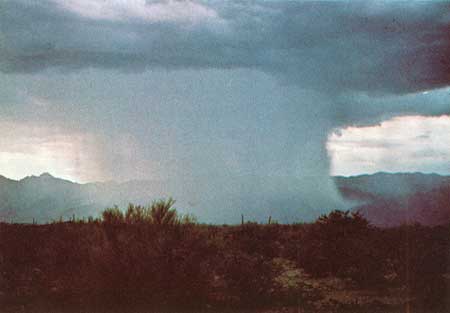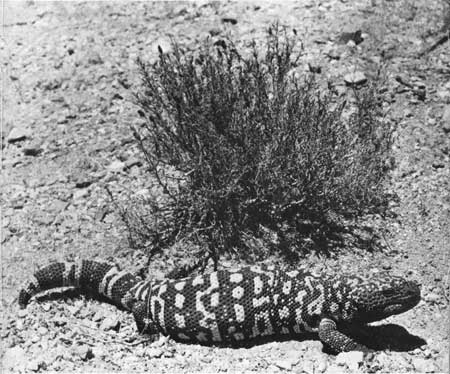|
SAGUARO National Park |
 |
climate: the vital factor
Climate is the chief arbiter of life on earth. Each plant and animal, including man, has tolerance limits for heat and water below or above which it dies. The Sonoran desert, with its low and uncertain rainfall and high summer temperatures, thus presents one of earth's most taxing environments. For most desert plants and animals, the main problem presented by this climatic combination is a scarcity of water. Why, we might ask, is this part of the globe so dry?
Essentially, the dryness of the Sonoran and other southwestern deserts results from their geographic situation. First, these lands lie east of a persistent high-pressure cell over the eastern Pacific—part of a belt of high-pressure cells which encircles the earth at this latitude. High-pressure systems in the Northern Hemisphere have descending, warming, dry air in their middles and along their eastern sides. The air that flows eastward from the "East Pacific high" thus contains little moisture, and dictates desert conditions over much of the Southwest. Furthermore, the mountains that more or less ring these deserts intercept much of the meager incoming moisture, by forcing the air to rise and cool so that its moisture condenses and falls to the ground.
 Summer thunderstorm in the Rincon Mountain Section. The Catalina Mountains rise in the background. (Photo by Harold T. Coss, Jr.) |
But during two periods of the year, the desert does receive rain. In winter, the East Pacific high shifts southward with the sun, reducing its effects on the Southwest. Now the low pressure storm systems, which at this season move eastward across the continent, can sometimes dip far enough south to bring rain to the Sonoran Desert. These rains are usually gentle, and cover large areas. Their clouds may cover the sky for several days at a time.
By April, the East Pacific high has returned far enough northward to resume its control of southwestern weather. Now the fore-summer drought sets in, intensified by gradually rising temperatures. Day after day the sun climbs higher in the sky, baking the earth and testing the endurance of desert life. Then, sometime in late June or early July, clouds begin forming in the afternoons over the mountains; finally, one day they build up to great thunder-heads. The drought ends suddenly as rain pours down and lightning cracks the sky. Down the canyons and along the desert washes rages the water, brown with soil. In a short time, the storm is over, and the water disappears into the ground. Just 1 mile away, rain may not have fallen.
These intense, local summer rains, so different from the winter ones, have a different origin as well. They are spawned by the Atlantic's Bermuda high, which has shifted northwestward and sent moist air from the Atlantic and Gulf of Mexico flowing off its western edge toward the deserts. This air rises quickly when it strikes hot, high mountains such as the Rincons, and its moisture condenses to fall as rain.
 Gila monster. (Photo by George Olin) |
Some time in September the rains of summer stop, as the Bermuda High moves south again, removing its influence and returning the East Pacific high to a position of dominance. The sun and wind again wring moisture from the soil, but with diminishing effect. The thermometer no longer reaches the 100's as it did in June, July, and August. In November or December, the winter rains begin. Water stays longer in the soil, because temperatures now range between 30° and 80°. Life in the desert begins a new cycle. This rainy period usually lasts into March.
On the mountain slopes, of course, the same seasonal patterns of heat and precipitation occur, but they are tempered or enhanced by elevation. With increasing elevation, temperatures decline and precipitation increases. When July temperatures at headquarters are averaging in the nineties, they will be in the sixties on top of the Rincons. In the cactus forest at the foot of Tanque Verde Ridge only about 10 to 12 inches of rain fall in a year, while Manning Camp, at 8,000 feet, gets about 18 to 25 inches. These up-slope gradients of temperature and precipitation, as we shall see, have pronounced effects on plant and animal life.

|

|
| NPS History | History & Culture | National Park Service | Contact |
|
Last Modified: Sat, Nov 4 2006 10:00:00 pm PST |


